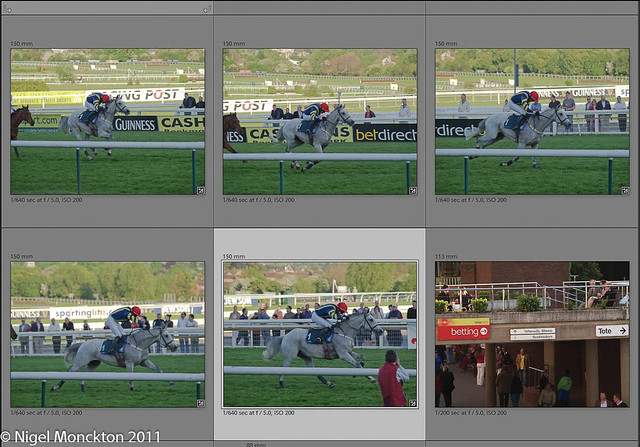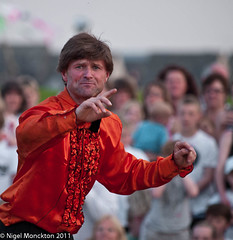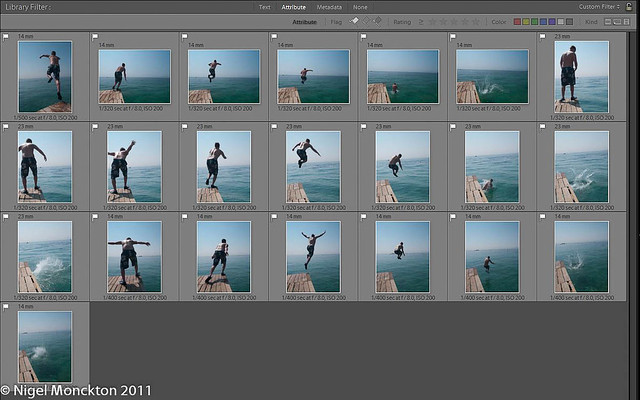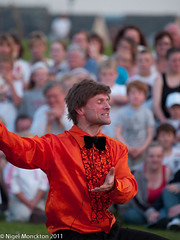Another dismal day scuppers my plans to go into one of the nearby tourist hotspots for a go at this exercise, so in a bid to retain some momentum I’m going to dip into my archive again.
As the notes indicate there are two ways to try to capture the ‘moment’ which could perhaps be paraphrased as ‘machine gun’ or ‘sniper’. The first involves taking several shots in quick succession – or perhaps just even a huge number of shots -and picking the best, the second involves learning to anticipate the moment and catch it with a single shot.
Machine Gun
A couple of examples – first up this selection from a horse race at Cheltenham which I took in May 2007:

These are not the greatest shots in the world – my view was obscured by the rail and this part of the course was in shade against bright sunshine in the background, but there is enough here to illustrate a couple of things.
- The camera was firing at about 2 frames a second. With a shutter speed of 1/640 it captures less than 0.2% of the action. Even at 10fps it would only capture 2%. So getting a ‘decisive moment’ is not guaranteed.
- Within the 2-2.5 secs of the sequence above there are very distinct poses, some of which are more successful than others. The first is quite static – the horses legs are more or less four-square. The second has a sense of urgency – the legs are in the classic galloping position and the rider is starting to rise from his seat. The third has the rider in a nice position, but the horse looks as if it is falling forward. In the fourth the leg position is reminiscent of old-fashioned paintings, and in the fifth it looks like the horse is trying to slide to a halt. For me the second shot is the most effective – whether it is possible with practise to anticipate this moment rather than machine gunning for it I’m not sure. I suspect it is.
In this second example I am still using the continuous shooting mode. This one differs from the last in that Ashley was modelling for me, and I had an idea of the type of shot I wanted before I started, so in some ways this also relates to Exercise 6. As with the horse above, it was difficult, at my level of skill, to anticipate the key moment so I had, to some degree, to rely on chance.
The best shot (middle of the third row) catches the event well I think. The alternative way to obtain this would have been to ask Ashley to repeat the jump several more times while I concentrated on getting a single shot at the peak of his jump. This may have worked reasonably well because there is a moment of relatively limited motion at the top of a jump. This is the kind of technique I have classified as ‘sniping’.

Sniper
For the next couple of shots, taken at an outdoor event in 2009, I was trying to capture expression a shot at a time, while trying to get a range of expressions.


The first – if I recall accurately – was rather easy because it was the finale of a particular trick and the guy in the red shirt held the pose for a couple of seconds, the second was a mix of anticipation and chance. The risk of this approach is that you only get one chance to get it right, so that the following shot has clearly missed the moment because he blinked as I pressed the shutter and the hand position is wrong. I think it likely that I would still have missed the shot with a machine-gun technique, although I shall never actually know.
Summary
Machine gunning or sniping? It seems to me both have their place although for my own part I’m not totally convinced by machine gunning. For fast action sequences – particularly if they are repeated it seems likely to give a good chance of results, although depending on the activity it may be as effective to concentrate on the single shot. For more general shooting good results can easily be obtained by trying to anticipate the moment – indeed the sound of the continuous shooting mode may be unhelpful in some situations.


No comments:
Post a Comment